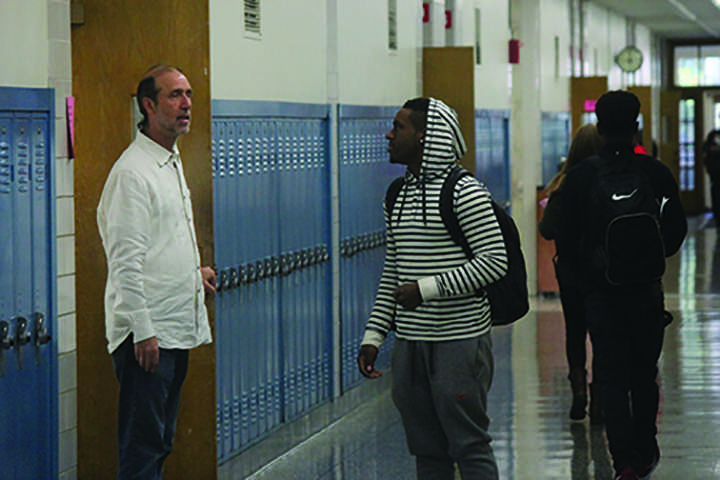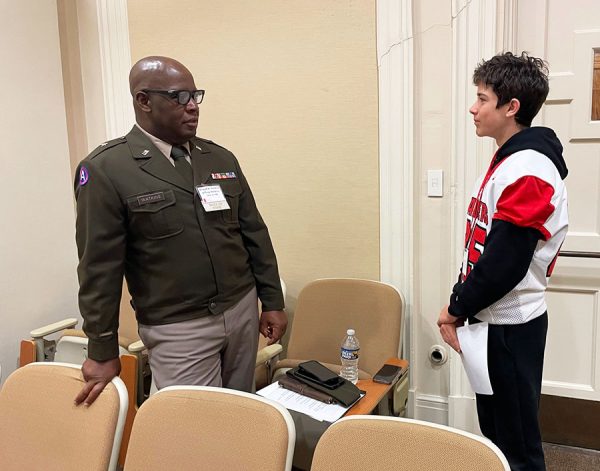Tardy Policy Changes School Dynamic
Reinforcement of neglected protocol leads to culture shift
Tony Cuda welcomes students into class prior to the tardy bell. Teachers are instructed to shut their doors to late students after the bell sounds.
Once crowded with students leisurely approaching their classrooms, the high school’s hallways are now virtually empty when the tardy bell rings.
The new tardy policy states that classroom doors will be locked after the second bell.
If students show up after the tardy bell, they must visit one of two tardy-slip stations, located on the first and second floors, and obtain a green pass.
Students are then given five minutes to return to class in order to avoid an unexcused absence.
Students who are legitimately late – because of finishing a test, for example – will be issued pink passes to distinguish them from those who are unexcused.
Students who accumulate five unexcused tardies will be required to serve and extended-study detention after school. After 10 unexcused tardies, they will receive an in-school suspension.
“There has never been a school that has allowed folks to be tardy to class with no repercussion,” Principal James Reed III said.
In the first month of school, teachers expressed their satisfaction with the policy.
“Students are rarely late to class. It means more to the students to get to class on time, which makes it a better learning atmosphere,” science teacher William Scanlon said.
French teacher Suzanne Genillier said the policy is the first time everyone in school is united.
“I thought it was time we did something to show this is a learning institution,” Genillier said.
“This year, with the exception of first period, I have had pretty much no tardies,” said science teacher Evan Zuzik.
“I don’t have to restart my lesson and I could actually use all of my teaching time.”
Reed explained the technical and financial importance of students’ attendance.
“Funding is determined by how many students you have in class. There is a push in the state to check by hour,” said Reed. “If we say we have 1,700 students here, but on any given day we can only show 1,300 here, it puts up a red flag for folks looking at state funding.
“It’s incumbent upon teachers to have accurate attendance. It’s incumbent upon students to be in class. We never know when the state will check, and they simply ask for our attendance,” Reed added.
Reed explained the usefulness of training students to be on time. “I also think it’s part of what we do here, train for the next stages of their lives,” Reed said.
“For some folks who are going into the field of work, it’s one of the most useable skills we can give them. There are very few jobs [to which] you can go when you want to.”
Spanish teacher Kimberly Ponce De Leon echoed that idea.
“I think it’s important to teach them now, at this stage in your life, that there are consequences for your actions,” she said.
Unsurprisingly, seniors have been comparing the new approach to their previous years and don’t share teachers’ enthusiasm for it.
“I understand why they’re doing it,” said senior Jessica Morford. “I just don’t think it’s very efficient, and a lot of students are upset about it.”
“I think their idea behind it makes sense — to try to make all the kids get to class on time and get a consequence if they are late,” added senior Mara Madden.
“Then it causes the students to be later because they’re getting the green pass, which is not efficient for the student,” she said.
“Until this year it was basically in the hands of the individual teachers. Some marked tardiness, and some really didn’t care if you weren’t being disruptive. In my experience it was sufficient, but I did witness students roaming the halls aimlessly sometimes,” said senior Margi Weiss.
“In the past three years most teachers were understanding if you came to class late, and the rules were not enforced,”senior Grace Rostetter added.
Ponce De Leon expressed concern about that inconsistency.
“What I am afraid of is that it becomes too unwieldy to manage and that there are too many consequences to enforce and that people are going to backpedal on the consistency of it and just say, ‘Well if they’re only a minute late then we’re just gonna not give them a pass and not give them a consequence.’
“And then it’ll be two minutes late, and then it’ll be five minutes late and then it’ll be 20 minutes late,” she said.
“Ever since freshman year, I’ve tried to never be late. I don’t like the idea of it and I don’t like to miss class,” Madden said.
“The only effect it has on me is that it’s annoying to have people walk in and disrupt class,” she continued.
“My routine hasn’t changed much, but my mentality has,” Weiss said.
“Getting yelled at constantly in the halls to rush to class is making me resent going. Getting scolded every day for doing my best to get to class is just frustrating. Having doors locked in kids’ faces is not the way to create a hospitable learning environment. It’s the opposite,” Weiss added.
With students questioning how long the tardy policy will last, past policies that were similarly enforced at the beginning of a school year and later disregarded came to the minds of students and teachers.
“I definitely think that the phone policy has been one that didn’t really stick,” said Ponce De Leon.
Scanlon agreed. “The rule didn’t stay because no one was enforcing it,” he said.
Dr. Michael Horvath, associate professor of industrial-organizational research at Cleveland State University, explained generally what it takes for an organizational change to succeed.
“One should try to minimize resistance to the change.” said Horvath. “To do so, one would want buy-in from all levels of the organization.
“This can be done in many ways. For instance, the individuals leading the change process could clearly and convincingly communicate the need for the change and respond to any anticipated concerns or questions.
“Some processes include members of all affected groups on the change team, in order to ensure that all groups perceive that their voices are heard.
“The organization should also demonstrate a commitment to the change through consistent communication and actions from the leadership – thus showing their buy-in.”
Ponce De Leon said the high school climate prior to this year was at times disruptive.
“There was definitely some things lacking in the climate of the high school in order to have a civilized climate, and one of those things was just that the halls were so rowdy and disruptive to teaching and it was very difficult to have class going on with kids entering whenever they wanted,” she said.
“So, prior to [the new policy] it was disruptive, it was unwieldy in terms of management and there wasn’t one sound policy for everyone.
“Everyone kind of had their own individual policies, and so students also didn’t know what to expect.
“I think that all those things combined really led to not having a climate that was conducive to learning and to teaching.”
Reed said the inconsistency in policy enforcement leads students to troubling conclusions.
“I think that the students here at the high school believe there are two high schools,” Reed said.
“There are students for whom consequences are given for their tardiness, there are students whose consequences are looked over. So once you have a situation that is diverse, like we have here at the high school, you can’t have folks believing that there are two rules for the same kind of occurrence.”
Ultimately, the tardy policy is intended to make classrooms more inviting than the halls.
“If we can make it uncomfortable for folks to be out in the hallways rather than in classes, then all of us will benefit,” Reed added.
“Those students who need a great deal of support and those students who need less support, those students who are intrinsically motivated by school and those students who are not.”






